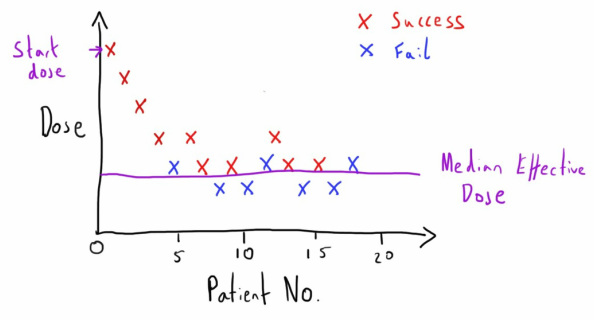
What's It About?
Up-down what? This was my first question when reading this paper having never come across the approach before, so I’ll take a couple of lines and a dodgy drawing to try and explain it. This design uses the outcome of the patient before the current patient to determine what dose you will use. A success-fail binary outcome is predetermined (in this case the degree of motor blockade) and a predetermined starting dose is given to the first patient (in this case 7.5 mg of 0.75% plain bupivicaine). If the result is a success then the next patient gets a dose that has been reduced by a predetermined aliquot (0.75mg) and they see if this is a success or a fail. When a patient has a ‘fail’ outcome, the next patient gets their dose increased by the predetermined aliquot. This continues with the dose going up and down depending on the success or failure of the dose with the preceding patient. The result is an oscillation around the median effective dose that we are interested in. If there are 6 or more oscillations then we can be reasonably confident with the median line they have centred on.
What Did THey Find?
Is It Any Good?
One niggling point is the fact that the volume of injection also varied with the dose, meaning that the older cohorts got a significantly lower volume as well as total local anaesthetic dose. The authors noted at the start how these interlinked factors of dose, volume, concentration and baricity are all important factors in the effect of spinal anaesthetic, and the dose and volume have been changed simultaneously in this study, making unpicking the difference a challenge.
Finally, whilst the ED50 has greater accuracy in identifying the differences in drug potency, it doesn’t have immediate clinical applicability. Rather it is the ED95 or higher that we are wanting for our patients (a 50% chance of the anaesthetic working just isn’t good enough for some people...). As noted in some of the links on the up-down sequential allocation technique, problems with analysing this stem from the plateau nature of the dose response curve at higher levels, hence the use of the ED50 instead. It still tells us a great deal about the relative potency of bupivicaine as age increases, we just have to apply that knowledge clinically.
Final Thoughts
Thanks for reading and as always please let us know your thoughts.
Tom Heaton
Link to Paper - The discussed article from 'Anesthesia & Analgesia'
Explanation of up-down sequential allocation technique
NAP 3 - The 3rd RCOA National Audit Project looking at central nerve blocks

 RSS Feed
RSS Feed
